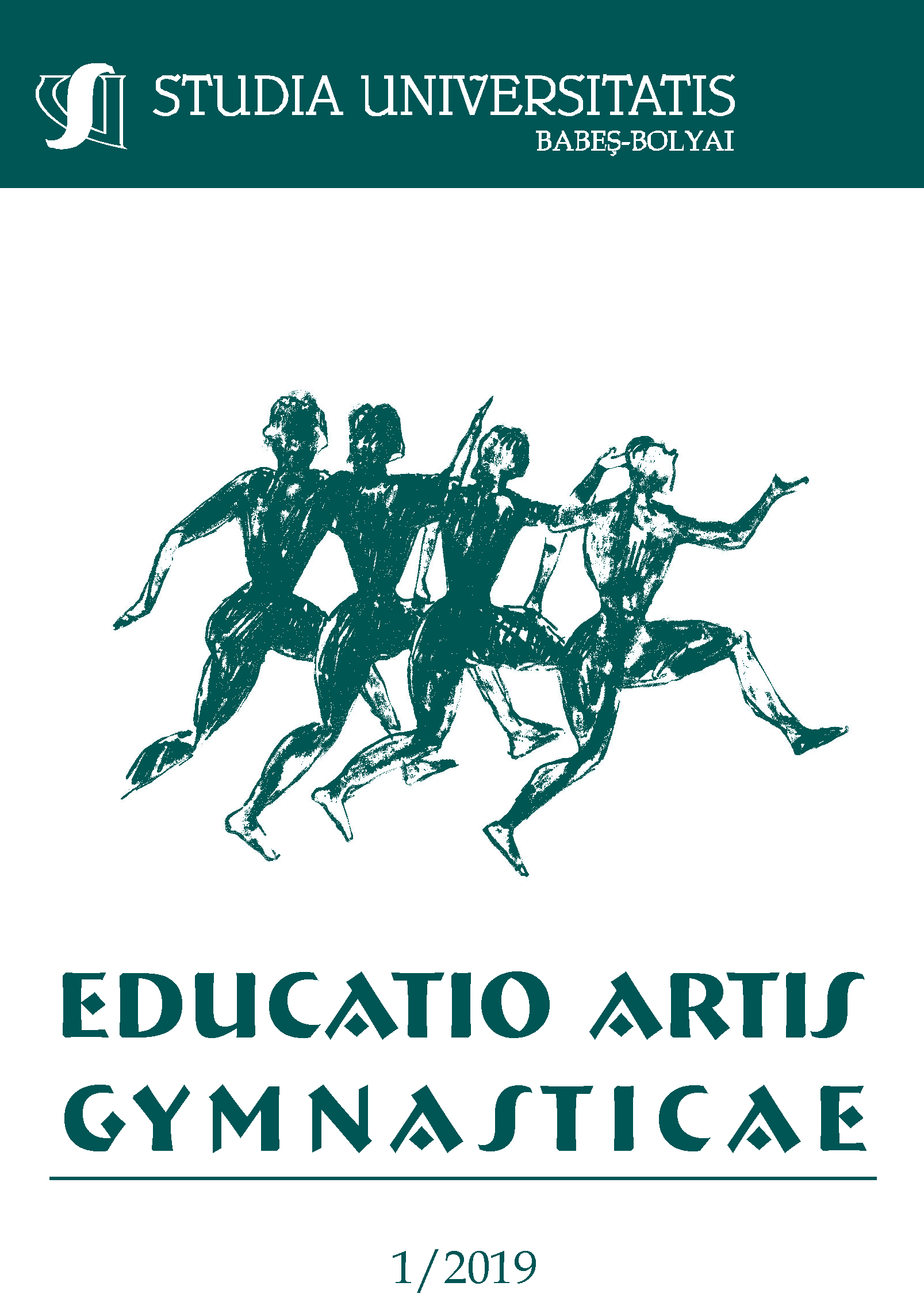COMPARISON OF PHYSIOLOGICAL RESPONSES BETWEEN INTERVAL METHOD, 8V8 AND 4V4 GAMES AND TECHNICAL-TACTICAL EXERCISE IN SOCCER TRAINING
DOI:
https://doi.org/10.24193/subbeag.64(1).02Keywords:
soccer, lactic acid, heart rate, interval training, 4v4, 8v8, technical exercises.Abstract
Purpose: Football is a sport that requires strong player demands. During the workout of improving the endurance are used exercises with or without the ball as well as racing games. In the present study we analyzed the burden of 4 different types of exercise(intermittent without the ball, 8v8 game, 4v4 game, and technical exercises) to determine which kind is best suited for improving the specific endurance. Material: The sample was 5 professional players (mean ± SD) of age (26± 2.9 years), height (1.79 ± 0,03m) and body weight (75± 3 kg). Prior to the experiment, a Test to determine the anaerobic threshold was performed. Measurements of lactic acid were made by using the Dr Lange photometer, while heart rate measurements by using POLARFT60 portable heart ratemeters. Results: The assumption of normal distribution was verified using the Kolmogorov-Smirnov test and it was found that in all variables the data follows the normal distribution. For the statistical treatment of the data a Analysis of Variance for repeated measure was used and for the detection of statistically significant differences between the measurement conditions was used the LSD multiple comparison test. The level of significance was defined as p<0.05. The analysis of the results showed that there is a statistically significant difference between the different types of exercise: a) the concentration of lactic acid (F3,12) = 11,053, p<0,05), b) in the min of heart rate >4mmol lactic acid (F(3,12)= 21,331 p<0,05). c) in the min of the heart rate at 3-4 mmol lactic acid (F(3,12)= 3,584, p<0,05) d) in the min of heart rate at 2-3mmol lactic acid (f(3,12= 4,310,p <0,05) and e) averages of the heart rate relative to ANK (F (3,12)= 25,404, p<0,05). Conclusion: It seems that the 4 different types of exercise cause different metabolic processes of lactic acid production as well as different heart rate responses. The intermittent and 4v4 game schedule is better suited to improving the endurance the 8v8 game is suitable for improving aerobic endurance, while technical-tactical exercises do not produce sufficient stimuli to improve endurance but involve speed stimuli.
References
Aster Los Arcos, Juan Sebastian Vazquez, Juan Martin, Javier Lerga, Felipe Sanchez, Federico Villagra, Javier J Zulueta (2015). PLOS ONE 10(9) September 2.
Alexander Dellal, Karim Chamari, Antonio Pintus, Olivier Girad, Thierry Corre and Dominique Keller (2008). Heart rate responses during small-sided games and short intermittent running training in Elite soccer players: A comparative study. Journal of Strength and Conditioning Research, Volume 22, Number 5, September,1449-1457.
Antoni Natal Campos Rebelo, Pedro Silva, VincenzoRango, Daniel Barreira and Peter Krustup (2016). Differences in strength and speed demands between 4V4 and 8V8 small-sided football games. Journal of Sports Sciences, Vol 34, No 24, 2246-2254.
Arcelli/Ferretti (1998). Fusball Konditionstrainig. Edizioni Correre (s 43-44).
Bangsbo, J. (2006). Preparazione fisico atletica del calciatore. Calzetti-Mariucci Editori, Via delSottopasso 7, 06089 Torgiano PG (s 119).
Cappanna (2000). Riflessioni e proposte per ilgioco del calico. Edizioni Nuova Prhormos. Via O Bettachini 3, 06012 Citta di castello (Pg) (s 90-125).
Grosser/Brueggemann/Zintl: Leistungssteuerung in Training und Wettkampf (1986). BLV VerlagsgesellschaftmbH, 80000 Muenchen 40, (s 178).
Harre, D. (1982). Trainingslehre. Einfuerung in die Theorie und Methodik des Sportlichen Trainings. Sportverlag Berlin (s 172).
Hoff, J., Helgerud, (2004). Endurance and Strength training for soccer players. Physiological consideration. Sports Med., 34(3):165-180.
Hoff, J., Wisloff, U., Engen, L. C., Kemi, O. J., Helgerud, (2002). Soccer specific aerobic endurance training. Br J Sports Med., 36:218-221.
Fanchini Maurizio, Azzalin Andrea, Castagna Carlo, Schena Federico, Mccall Alan, and Impellizzeri Franco M (2010). Effect of bout duration on exercise intensity and technical performance of small –sided games in soccer. The Journal of Strength and Conditioning Research 0(0)/1-6.
Fucci A, Esposito F (2006). La metodologia della llenamento applicata alla preparazione Fisicanel calico. Casa Editrice Scientifica Intermazionale. Via Cremona 19. 00161 Roma (s 24-30).
Impellizzeri FM, SM Marcora, C Castagna, T Reily, A Sassi, FM Iaia, E Rampinini (2006). Physiological and Perfomance Effects of generic versus Specific Aerobic Training in Soccer players. International Journal of Sport Medicine 27(6),483-492.
Jastrebski, Z., Barnat, W., Dargiewicz, R., Jaskulska, E., Szwarc, A. Radziminski, L (2014). Effect of in-season generic and soccer-specific High-intensity interval training in young soccer players. International Journal of Sports Science and Coaching. Volume 9, Number 5, 1169-1179.
Jan Helgerud, Lars Christian Engen, Ulrik Wisloff, and Jan Hoff (2001). Aerobic endurance training improves soccer performance. Medicine & Science in Sports & Exercise 33: 1925-1931.
Martin D (1979). Grundlagen der Trainingslehre. Band 63/64. Verlag Karl Hofmann. 7060 Schorndorf (s 145).
Pate RR, and Kriska A (1984). Physiological basis of the sex difference in cardiorespiratory endurance. Sports Medicine Volume 1: pp:87-98.
Sassi R (2008). Qualleresistenzanel calico? In “La preparazione atletica del calciatore” Calzetti-Mariucci, Via del Sottopasso 7, 06089 Torgiano PG (s 89-96).
Sassi R/Tibaudi A (2004). La modulazione del carico nella preparazione del calciatore. Calzetti-Mariucci Editori, 06087 Ponte San Giovani-Perugia (s 91).
Schrey R/ Feil W (2012). Die perfekte Fussballschule. Suedwest Verlag, 81637 Muenchen (s 56,125).
Steven Jones and Barry Drust (2007). Physiological and technical demands of 4V4 and 8V8 games in Elite youth soccer players. Kinesiology 39, 2:150-156.
Weineck J, Erlangen (1992). Optimales Fussballtraining.Teil1: Das Konditionstraining des Fussballspielers. Beitraegezur Sportmedizin; Bd 43. (s 68).
Wienecke, E. (2007). Fit gewinnt! Philippka-Sportverlag, Postfach 150105, D-48061 Muenster.
Zintl, F. (1988). Ausdauertraining BLV Verlagsgesellschaft mbH, 80000 Muenchen 40 s 1.
Downloads
Published
How to Cite
Issue
Section
License
Copyright (c) 2019 Studia Universitatis Babeș-Bolyai Educatio Artis Gymnasticae

This work is licensed under a Creative Commons Attribution-NonCommercial-NoDerivatives 4.0 International License.



